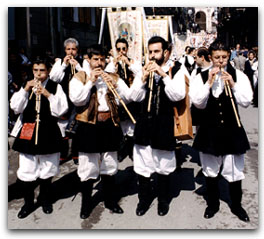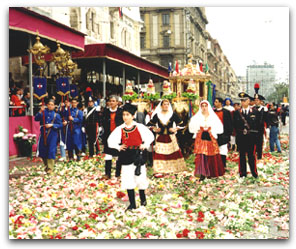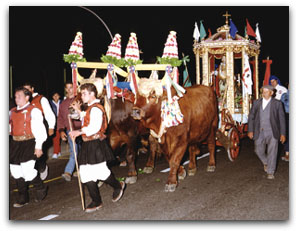The music of the "launeddas",
which are traditional Sardinian pipes, precedes the statue of the saint as it passes among the
crowd, who are overcome with emotion and throng to touch the coach in this centuries old
ceremony.
Efisio passes among his people who have not forgotten his interventions for Cagliari and
Sardinia as when, in 1793, he freed the city from the French siege. In 1943 (during the second
world war) the statue was carried through the city, that had been bombed, giving the people
hope during that time of pain, tears and desperation. Even on that occasion the population
managed to rebuild the city in only a few years.
|
|
 |
 |
|
As the statue of the saint arrives in
front of the city hall, passing through Via Roma whose paving stones are covered in flowers
(the so called "sa ramadura" rite), the saint's coach is greeted by the sirens of the ships in the
port and by the cheers of the people who make the sign of the cross as the statue of the saint
passes.
At that point the Festival becomes a countryside festival with the statue of the saint passing
through the villages of La Maddalena, Su Loi, Sarroch, Villa San Pietro, Pula and Nora and
small festivals are held along the route, with religious ceremonies and banquets, where
everyone is invited as a sign of welcome and hospitality.
|
On the 4th of May the statue of the
saint begins its return journey to Cagliari. Late in the evening, the statue of Sant'Efisio is
accompanied by thousands of worshippers carrying torches, back to the church in Stampace.
The worshippers crowd to enter the little temple in order to be near "their" Saint again.
The greeting that people exchange is "Atrus annus" which means "other years", because on the
5th of May in Stampace people are already thinking about the next festival.
It has been so for 353 years.
|
|
 |
|